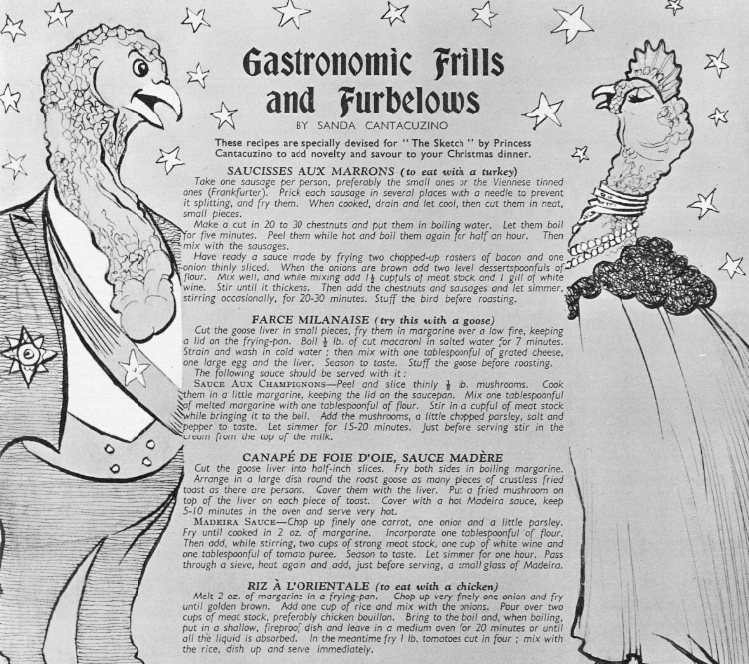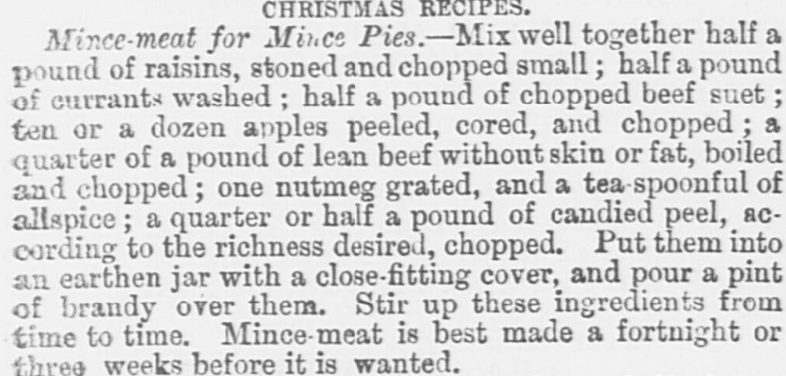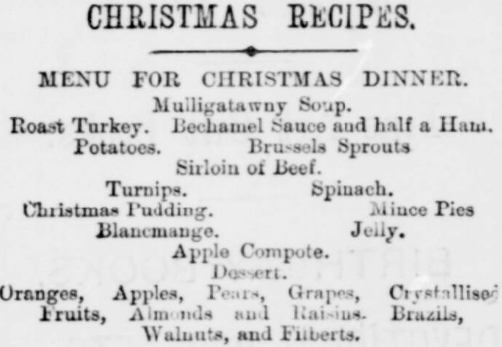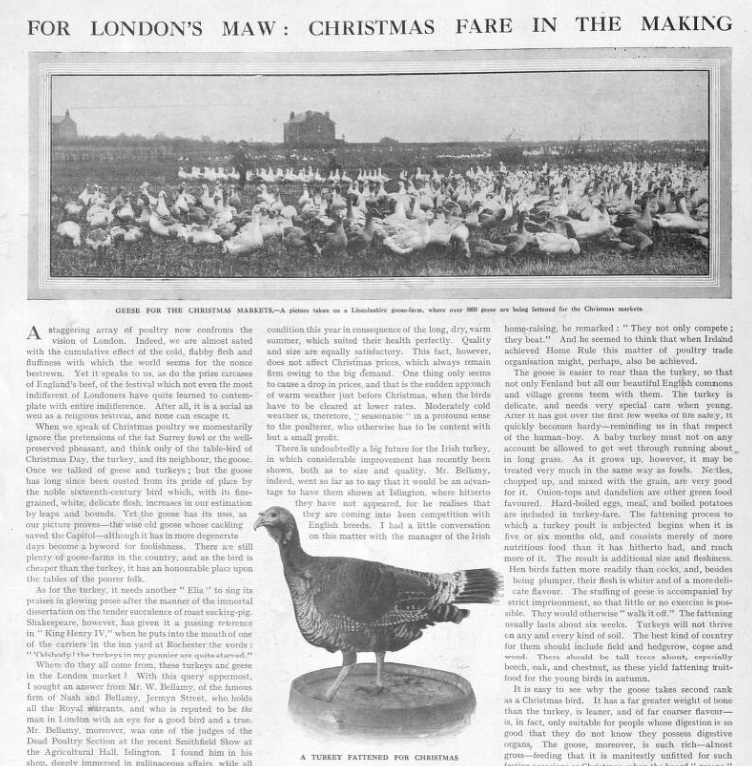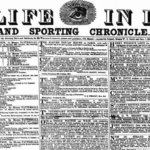As we approach Christmas, we at The Archive were curious to uncover Christmas recipes from the past through our newspaper collection. Would we find them to be similar to our usual Christmas feasting fare? Or would the festive food of days gone by have fallen out of favour?
Well, we’ve sourced 22 delicious and unusual Christmas recipes from our newspapers to help us answer these questions. From herring pies to plum puddings, from orange cakes to mince pies, we will uncover the enduringly popular Christmas recipes from history, as well as those recipes that have fallen by the wayside in our special Christmas recipe countdown.
Register now and explore the Archive
Who knows, you may even be tempted to try some of these yourself this Christmas.
1. Mince pies – December 1877
We are going back to the Victorian era now for our earliest Christmas recipe, which is a familiar one: mince pies. This mince pie recipe was printed by the North Devon Journal on 20 December 1877 and contains two separate mincemeat recipes: one for mince pies, and the other for ‘old fashioned mince meat,’ the latter of which features actual meat in the shape of beef.
As for the ‘mince meat for mince pies,’ the newspaper advises that the mixture be placed in an ‘earthen jar with a close-fitting cover,’ and doused in a ‘pint of brandy.’ Ideally, the ‘mince-meat is best made a fortnight or three weeks before it is wanted.’
2. Nightingale pie – December 1891
In December 1891 the Warwickshire Herald presented ‘some old Christmas recipes,’ which had been sourced by fellow publication Hearth and Home from all the way back in 1685. The Warwickshire Herald noted how they supposed that these Christmas recipes would be ‘unknown to the generality of people.’ Perhaps because of this, the paper printed the directions, with this particular recipe being for a nightingale pie:
Make of puffe paste an artificial hen, her wings displayed, sitting upon eggs also ye paste, wherein each shall be enclosed a fat nightingale seasoned with pepper, butter, ambergris and verjuice.
The newspaper went on to remark how ‘this is a very remarkable dish, and the fat nightingales are rather difficult to procure.’
3. Herring pie – December 1891
From the same Warwickshire Herald article, we sourced another pie recipe, this time for herring pie, which could also be traced back to 1685. This recipe runs as follows:
Take salted herrings, being well watered, wash them between your hands, and ye shall loose ye skin from ye fishe. Take off ye skins whole and lay them aside; then have a pound of almond paste ready, mince ye flesh of ye herrings, and stamp them with the almond paste, and two of ye miltes or roes, five or six dates, some grated manchet, sugar, sack, rosewater, and saffron; make ye composition somewhat stiffe, and fill ye skins therewith.
Put butter in ye bottom of ye pie, lay on ye stuffed herrings, on them put dates, gooseberries, currants, barberries, and butter: close it up and bake it. Being baked, liquor it with butter, verjuice, and sugar.
Do you fancy making this herring pie?
4. Mulligatawny soup – December 1891
Now for something to our modern tastes that seems a little unusual for the Christmas table – soup! But not just any soup, mulligatawny soup, which was featured as part of the Devizes and Wilts Advertiser’s Christmas menu, amongst other Christmas recipes, on 24 December 1891.
Mulligatawny soup originated in Tamil cuisine, with its popularity rising in the 18th century. By at least 1824, it had become popular in Britain.
Here is the Devizes and Wilts Advertiser’s recipe for it:
5. Turkey stuffing – 1898
The next of our Christmas recipes is a short one, and it comes from Blackburn’s Northern Daily Telegraph. Published on 21 December 1898, the recipe was for turkey stuffing. Claiming to be the ‘simplest’ of all stuffing recipes, it called for you to:
…empty the skins of a pound or more Cambridge sausages, sprinkle over it a few drops of lemon juice, add some sweet herbs to flavour, and season to taste.
6. Christmas bowl – 1898
The Northern Daily Telegraph had another Christmas recipe up its sleeve in December 1898, and this time it was for a sweet dish, which could make an incredible centre piece.
Calling for ‘nine penny spongecakes, 1/4 lb of macaroons, a pint of raisin wine, half a pint of sherry, 2oz of powdered sugar candy, a pint and a half of custard,’ this sweet and boozy special could be placed on ‘a stand ornamented with Christmas evergreens.’
7. Christmas pudding – 1906
From a Christmas bowl to perhaps one of the most iconic of all Christmas recipes: the Christmas pudding. On 30 November 1906, well in time for Christmas, Warwickshire’s Midland Counties Tribune gave its recipe for a Christmas pudding, which needed to be steamed for ‘five hours or longer:’
One pound breadcrumbs, 1/2lb each chopped sultanas and currants, 2oz. each blanched almonds, Brazil and hazelnuts all grated, 1/2lb moist sugar, 2oz. finely-cut candied lemon, large cupful apple sauce, a teaspoonful of nutmeg grated, 4oz. butter, melted and creamed, four beaten eggs. Mix well, put in a bowl and steam for five hours or longer.
8. Roast goose and apple sauce – 1908
Although turkey tends to steal the starring role on Christmas day, historically in Britain it was goose which was the centrepiece of a Christmas meal. On 26 December 1908 (a day after Christmas, but one to cut out and keep), the Tewkesbury Register printed an array of Christmas recipes, including one for roast goose and apple sauce.
Prior to starting, the newspaper advised that the ‘bird is better trussed by the poulterer.’ After this, the crop of the goose should be filled with ‘forcemeat,’ which is a mixture made with a ‘teacup of breadcrumbs, nearly one of minced suet, a tablespoonful of thyme and lemon juice, with one tablespoonful of minced parsley, pepper and salt to taste, on shallot minced.’
Milk should then be added to this mixture, along with an egg. The goose should next be covered with butter or lard, and basted throughout the cooking process. This, declares the Tewkesbury Register, should result in the ‘perfect’ bird.
9. Milk punch – 1908
Another gem of a Christmas recipe to be published by the Tewkesbury Register is for a milk punch. With a kick of alcohol, this recipe calls for you to ‘take six Seville oranges and peel off the rinds very thinly, also six lemons, and treat in the same way, then steep the mixed rinds in three pints of rum or brandy for over 24 hours.’
Next up, ‘one pound of refined sugar, one and a half pints of water, a grated nutmeg, and nearly half a pint of lemon juice’ needed to be added to the mixture. Stirring in the sugar until it dissolved, the Christmas recipe now called for the addition of its namesake: ‘one and a half pints of boiling new milk.’
You needed to have some time for this recipe, as you had to leave it to stand until the next day, ‘closely covered.’ Then you could strain the mixture ‘through a jelly bag till quite clear.’
10. Mock turtle soup – 1909
We’re heading to Ireland now for our next Christmas recipes, starting with a mock turtle soup, which was featured by the Weekly Irish Times on 4 December 1909. This recipe, which you can read in full here, calls for separate saucepans containing ‘half a calf’s head…and half a pig’s head.’ The pig’s head would eventually need to be cut up and added to the saucepan containing the calf’s head, to which would then be added lemon peel, an onion, half a dozen cloves, lemon juice and mushroom catchup.
After straining, the mixture should resemble a ‘jelly,’ and it should be added to a pan with the meat, forcemeat balls and egg yolks. Finally, after simmering for another two hours, the soup should be served ‘very hot.’
11. Oyster and celery stew – 1909
The second of our Irish Christmas recipes again seems unusual to our modern ideas of a festive meal, and it is for an oyster and celery stew. Indeed, oysters used to play an important part of the British and Irish festive table. So without any further ado, here is the recipe from the Weekly Irish Times:
Stew two cups of cut-up celery until it is transparent, and the water all absorbed. Season with pepper and salt. Simmer a pint of oysters in their own juice until the edges curl; season these also and add to the celery. Thicken a cup of rich milk and pour over all, and serve on rounds of buttered toast.
12. Fried plaice – 1909
We’re sticking with the Weekly Irish Times for our next Christmas recipe, which also has a fishy theme: fried plaice. Perhaps today we’re more used to the idea of smoked salmon, say, on our Christmas table, but this recipe is a wonderful representation of the Irish tradition of fish and chips:
Carefully wash and dry a good thick plaice, and let it remain in a cloth until it is time to dress it. Brush it over with the beaten-up yolk of an egg, and cover with finely-crumbled bread-crumbs mixed with a little flour. Fry a nice brown in a hot dripping or boiling lard, and garnish with sprigs of parsley and cut slices of lemon. Serve with shrimp sauce or plain melted butter.
13. Boiled turkey and oyster sauce – 1912
From fried plaice now to boiled turkey, an interesting take on the traditional roasted turkey of many a Christmas day meal. This recipe was featured by another of our Warwickshire newspaper titles, the Atherstone News and Herald, on 20 December 1912. It called for a turkey to be added to a pan of hot water. When brought to the boil, turnips, parsnips, one onion, one carrot and bunch of parsley should be added to the turkey.
The paper describes what should be done next:
Allow all to simmer until a fork will stick easily into the chest. When this is done, dish the bird, take the turnips, and place them in a basin with a lump of butter according to the turnips. Season them with pepper and salt, mash together with two forks, then put the basin into a hot oven for a few minutes. When thoroughly hot, turn into a tureen.
The Atherstone News and Herald also included a recipe for a traditional roasted turkey, which you can read here.
14. Orange sponge – 1912
We’re in need of some sweet Christmas recipes now, and the Atherstone News and Herald does not disappoint. It provided the recipe for the ‘well liked and simple enough’ treat of orange cake, which could be served at a ‘children’s Christmas party.’
Here is the full recipe below, to be served with ‘whipped cream and oranges and divided into sections.’
15. Christmas log cake – 1912
Our final Christmas recipe from the Atherstone News and Herald is much more of a familiar one: Christmas log cake. This particular recipe calls for decoration with ‘chopped pistachio nuts.’
16. Cornish pasties – 1918
We fast-forward now to the end of the First World War, and the Christmas recipes that were published by the Aberdeen Press and Journal on 4 December 1918. The paper noted how ‘it is not easy to be hospitable these days when the rations allow,’ going on to observe that ‘scanty war-time hospitality may be worth more a great deal more than the more handsome entertainments of peace. True hospitality means sharing little as gladly as much.’
And in this festive, hospitable, spirit, the Aberdeen Press and Journal suggested the ‘economical, appetising, and satisfying’ Cornish pasty. According to the paper, ‘Cornish pasties are particularly popular with the English boys, of whom there are so many in the town.’ The recipe for Cornish pasties was budget friendly too, calling for flour, barley flour, margarine or dripping, steak or ‘any cold meat,’ potatoes, an onion, one carrot and some gravy.
17. Fish soufflé – 1928
We’re in to the 1920s now for our next Christmas recipe, which was featured in a W. Teignmouth Shore piece ‘Christmas Feast and Frolic‘ for Britannia and Eve, 14 December 1928. Teignmouth Shore, in this piece, designs a ‘Menu For a Simple Xmas Dinner (in English!).’
For starters, instead of offering soup, the author suggests a ‘fish soufflé,’ which he says will provide ‘the light and the sweetness’ to the meal. To make his soufflé, you needed to mince some cold boiled white fish; alternatively you could use crab meat or ‘the frivolous shrimp.’ A beaten yolk needed to be added to the minced fish, whilst before this you should prepare a mixture of milk and butter.
All this should then be beaten ‘into a very stiff froth’ and placed into a ‘well-buttered fireproof dish,’ baking for twenty or thirty minutes.
18. Clear fish soup – 1932
It seems Britannia and Eve were set on their fishy starters, as the magazine provided further fish-themed Christmas recipes, this time courtesy of cookery writer A.H. Adair in an article titled ‘Suggestions for the Classic Feast.’ Published on 1 December 1932, Adair presented his menu for a classic Christmas dinner, which began with clear fish soup, before moving on to a classic roast turkey, a traditional plum pudding, and finally, somewhat unconventionally, anchovies on toast.
But how to make the clear fish soup? Despair no more, here is the recipe:
Take one whiting, a half a pound of cod, and a few mussels. Clean and cut up the fish and put it in a large saucepan with the mussels, an onion, a carrot, a leek and the outside stalks of a head of celery cleaned and cut into pieces. Add a good piece of butter or two tablespoonfuls of olive oil, salt, pepper and a heaped teaspoonful of curry powder.
All this should be fried, and then boiling water should be added to the mixture. After simmering, the soup should be passed through ‘a very fine strainer.’
19. Wassail bowl – 1936
Let’s move on from the fishy Christmas recipes now with another alcoholic offering: the wassail bowl. This particular recipe was featured by the Liverpool Echo on 19 December 1936.
For this wassail bowl, ‘half a pound of demerara sugar, half a nutmeg grated, a level dessert-spoonful of bitter ginger, and a pint of beer,’ should be added to a saucepan and brought to the boil. Then to this mixture, ‘three more pints of beer, four glasses of sherry, and two or three lumps of sugar which have been well rubbed on the outside rind of a lemon,’ should be added.
The wassail mixture should then be brought ‘almost to boiling point’ and served in a ‘bowl with six small russet apples floating on top.’
20. Stuffed olives – 1938
On 14 December 1938 M. Palmer Jackson for the Coventry Evening Telegraph provided ‘some simple but attractive recipes for Yuletide parties.’ One of these Christmas party recipes was for ‘stuffed olives,’ for which you needed to ‘use croutons or crisp biscuits, six Spanish olives and pate-de-foie gras.’
The recipe runs as follows:
Spread the croutons with green butter, remove the stones from the olives with a small round cutter. Cut out circles of pate-de-foie gras with the same cutter, and place one in the centre of each olive. Put an olive in the centre of each crouton and decorate with the butter, using a small forcer.
M. Palmer Jackson also provided the recipe for the green butter, which was a mix of ‘cayenne, salt and pepper, and one tablespoonful cooked chopped spinach.’
21. Spiced beef – 1939
As the 1930s came to an end, ‘The Housewife,’ writing for Belfast title the Northern Whig on 18 November 1939 provided an array of Christmas recipes. These were listed with an eye on ‘present conditions,’ the first few months of the Second World War, with the ‘richer ones’ being modified accordingly.
One correspondent asked for an ‘early recipe for spiced beef,’ which The Housewife willingly provided, listing out the copious ingredients needed for the spice.
With the ingredients assembled, The Housewife directs:
Dry the salt, weight it, put in a crock with the saltpetre, and rub both together till entirely mixed. Then add the sugar and the spices and all the other ingredients, mixing thoroughly. If you can, first pound the spices together in a mortar, adding the carmine. The pounding blends the flavours.
22. Mullet claret – 1951
We’re back to Christmas drinks now as we enter the 1950s, and it’s only fitting that this our final recipe of the list, so we can raise a glass to these wonderful and unusual historical recipes. On 5 December 1951, The Tatler printed a Shena Reid recipe for ‘mulled claret.’
The recipe calls for ‘2 bottles of claret,’ which should be added to a saucepan alongside ‘1 lb. castor sugar and a muslin bag containing 6 cloves, 1/4 crushed nutmeg, 2 sticks of cinnamon and the toasted rings of an orange and lemon.’ The mixture should be stirred and heated, and when nearly boiling, the bag should be removed and the liquid ladled ‘into claret glasses with a small slice of lemon in each glass.’
Which of these recipes would you like to make? Discover more Christmas recipes in the pages of our Archive today.


